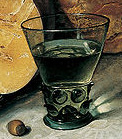Berkemeyer

Berkemeyer describes a northern European drinking glass shape that was in use in the 16th and 17th centuries. It is a variant of the Nuppenbechers . The Berkemeyer replaced the cabbage drink as a glass form and was the forerunner of the Roman .
In contrast to the cabbage drink, the Berkemeyer only has nubs on the hollow shaft ; In contrast to the Roman, its lip is conical and only became slightly bulbous in the transition period. The Berkemeyer often has a jagged or teardrop-shaped foot ring. First, the Berkemeyer was decorated with a diamond pattern. However, this design decreased and can only be traced back to the second third of the 16th century.
Forest glass was preferred as the material , although at least in Germany the production of colorless glass was known. There are also Berkemeyer copies made of stoneware from the 16th and 17th centuries.
Web links
Individual evidence
- ↑ a b c E. Baumgartner and I. Krueger (eds.): Phoenix made of sand and ash. Medieval glass. Munich 1988 (exhibition catalog Bonn 1988) p. 365.
- ↑ a b c E. Baumgartner and I. Krueger (eds.): Phoenix made of sand and ash. Medieval glass. Munich 1988 (exhibition catalog Bonn 1988) p. 366.
- ↑ Franz-Peter Wahrendorf, The Great Glass Collector's Glossary , p. 31.
